
tok tokkie
-
Posts
201 -
Joined
-
Last visited
Content Type
Forums
Profiles
Gallery
Blogs
Downloads
Events
Posts posted by tok tokkie
-
-
Nice mill! Good job on the fixture, looks pretty rigid.
Just out of curiosity, did you consider machining the original race bore to an oversize, and then pressing a collar into that? I'm just concerned that the TIG may have over stressed or increased the hardness of that part of the frame...
None the less, it looks like it got the job done and you did it right :D
It did not occur to me. It was suggested in one of the replys & I said I thought that would have been better. BLS said negative as that removes parent metal. If I did it again Ii would consider that option very seriously - take a good look at how much parent material would remain. The problem with the weld is getting right in there wheras with a thimble you know precisely what you are going to end up with. I will always have an element of doubt about the weld.
-
Flapper valve:
This is what Honda says in the Gen 5 Workshop Manual under Technical Features page 21-25. They call it the variable Air Intake System:
'OUTLINE
The intake area and the intake duct length are changed according to the engine revolution speed by opening/closing the variable intake duct, thereby contributing to upgrade the engine output.
From low speeds to medium speeds the intake is controlled by closing the variable intake duct to reduce the intake area thereby realizing high efficiency intake through upgraded inertial effect and pulsation effect of the intake air, and contributing to upgrade the low- and medium-speed output.
From medium speeds to high speeds the intake duct is opened to supply large volume of air to the engine, thereby contributing to the high revolution speed and power output of the engine.'
Next page shows the schematic of the components and explains that below the threshold rpm the flapper is closed, above it it is open.
It is generally believed on this forum that it is simply a noise abatement device. I am under the impression that it is thought that the flapper only closes at the noise measurement rpm range & that it is open below that - different to what Honda say (am I right?). I have removed the flapper & the snorkel but have not got the bike back on the road. I expect to replace the snorkel once I have tried it but possibly cut the inside away.
Honda's reference to 'upgraded inertial effect and pulsation effect' is Hermholz. The snorkel is thus the Heremholz duct as that is what is in operation at low speed when the flapper is closed. That would slightly raise the airbox pressure over a very resticted rpm range as Hermholz is to do with wave lengths matching duct lengths.
-
How many hours did this take?
tom
Two days I suppose for the welding & machining - remember I had to make a jig half way through the job & weld some more. I am in no hurry about this, just take it cool. I am doing a complete service of the bike to get it to a known starting point. When I opened the forks the oil was so filthy that I decided I had better check everything out. Plus I am also customising it to a degree - Frankenviffer fever has another victim.
-
Nice Job !
I had the same problem on a crashed 5th gen. VFR a few years ago, the front end impact popped/boke out this same lower bearing seat.
I thought I was screwed, but I thought about it for a while and decided to have my local machine shop just build an insert. They over bored the frame with a step and made a sleeve insert that was pressed into the new larger hole that had a much stouter seat .
Worked like a charm !
:beer:
That is a better solution in my opinion.
I have picked up so many ideas from this site. What I have learned is that I should have asked for advice and opinion here before doing anything. Sure, the opinions would have varied from 'get a new frame' to 'blow it up' but I would have chosen your method if I had asked the question & got the reply. This is a fantastic site.
-
BTW... did you weight the frame???
7.6 kg with lower inner race fitted.
-
I think the page you linked to with the recommendation for 50 ft/lbs to seat the races squarely probably comes from the good old days of steel frames.
I agree. Pity he did not say so in his write-up.
-
http://www.vfrdiscussion.com/uploads/1130622839/gallery_4545_662_462991.jpg[/img]
I wanted to post this under ?Adventures with my VFR? but that is limited to ride reports. It could possibly go in maintenance 'How to Guides' but really it is intended to show what NOT to do and I hope no one else has to do this.
I have made my contribution to the statistic of lapsed riders who return to motorcycling and quickly throw the thing down the road. It was a low side and the bike came off far better than me ? 3 cracked ribs & broken collar bone. Rashed plastics with frankenbolt holes popped & indicator pushed through to the inside & rashed muffler; would have been much less if I had a frame slider fitted. Radiator and mirror unbroken.
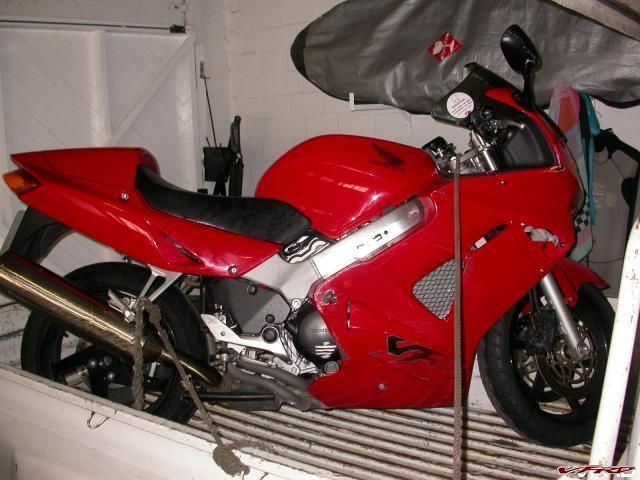 border='0' alt='user posted image' />
border='0' alt='user posted image' />Crashed & retrieved
When I came to sort out the mess I found that the steering was rattlingly loose. I bought a 2001 with 58 000 km on the clock; new steering head bearings had been fitted at 24 000 when the bike was 2 years old. I was very surprised that the steering was so loose as I had not noticed it before the crash although I had done 1200 kms. I came across
this link which advocates torquing the head to 50 ? 60 ft. lbs to properly seat the bearings. When I did this I heard 2 sharp cracks almost like bearing balls cracking but thought it was the sticktion as the bearing races settled properly against the seats, just as the article said they would. But things were obviously not right so I had to strip the front end off & see what was going on. When I got the steering stem out I found that the cracking noise was the cast in collar against which the lower bearing seats being broken off. I felt sick, sort of faint. From a relatively mildly damaged bike I had progressed it to being truly hugely damaged. Slept on the problem and decided to weld it up. This is going to be my final bike, I have no intention of selling it; will give it to my son when I am done with it. There is no way that I could sell a bike with a welded steering head to someone else but I am willing to ride it as I am confident in the repairs.
I have a tig welder but have never done aluminium tig welding. Next to me at work is a API(?) certified welder who has worked on oil rigs in the Persian Gulf and been an instructor at a local welding school ? I would get Ridwaan to do the welding. I have a cnc machining centre. A machining centre is like a milling machine but they are called machining centres for some reason ? there are horizontal or vertical ones. I have a Haas VF2 vmc made in California. So between the two machines I have and with Ridwaan?s help I should be able to fix this thing.
I stripped the frame off the bike; not too difficult as there was not much more that I needed to take off since the fairing was at the spray painter & the front end was out. Just take the tank right off and the tail section and loosen the wiring harness & the frame lifts off the remainder.
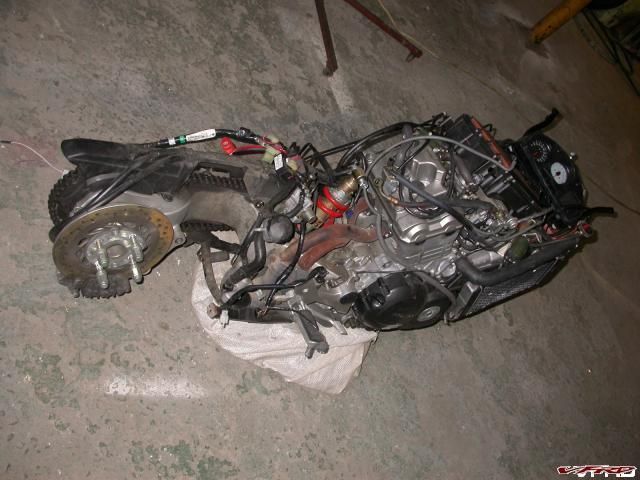 border='0' alt='user posted image' />
border='0' alt='user posted image' />no frame 3.jpg
Frame stripped off. Remains resting on sandbag
Ridwaan welded it up although it was quite difficult working within the confined space of the steering head. I then put the frame on the table of the Haas and sorted out how I was going to clamp it there while machining it. The vital thing is to machine the repaired lower bearing seat dead in line with the upper bearing seat. I made a steel disk that just fitted inside the upper bearing seat which I bolted to the table of the Haas and centered the spindle on it. Then I fitted the frame upside down onto that disk so the welded part was uppermost. I made another disk that just fitted the undamaged step where the dust seal fits under the lower bearing, this had a long 32mm tail that I fitted into a chuck so that it could slide up and down. I was then able to fit this into the spindle of the Haas and lower it into the steering head with the spindle accurately above the disk bolted to the table so the steering head was exactly where it needed to be. I sorted out how to clamp it in this position.
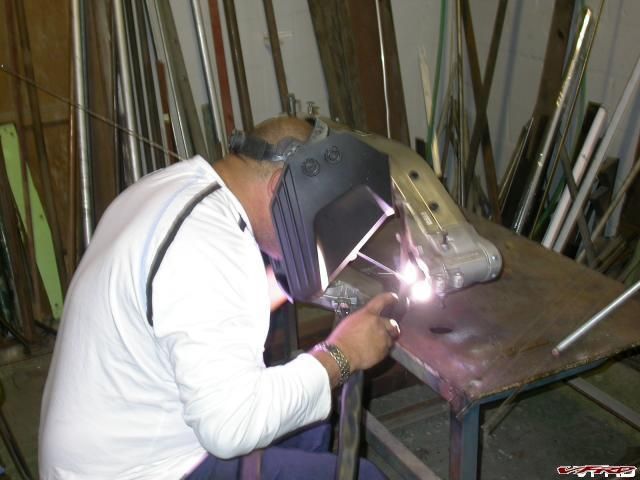 border='0' alt='user posted image' />
border='0' alt='user posted image' />tig 1.jpg
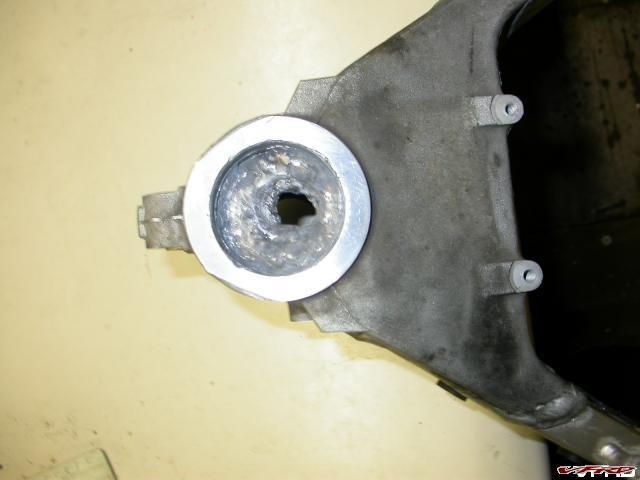 border='0' alt='user posted image' />
border='0' alt='user posted image' />welded 1.jpg
Welded
I machined away the excess material using a new 4-flute HSS (high speed steel) end mill. It clearly was not cutting well ? you can hear when things are cutting well or poorly. The rods that Ridwaan had used are really tough aluminium. When I had a look ? you can?t see what is going on while cutting as everything is showered in cutting oil ? I saw that this really was not the right tool as the aluminium was smeared and the job had shifted towards the back of the Haas as the clamping was not good enough. I had now overcut on the one side so Ridwaan had to fix that up again. The tool was badly worn.
 border='0' alt='user posted image' />
border='0' alt='user posted image' />machine 1.jpg
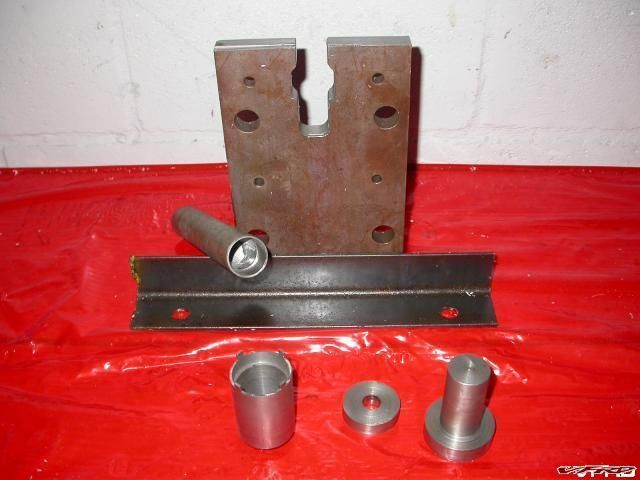 border='0' alt='user posted image' />
border='0' alt='user posted image' />machinig fixture 3.jpg
The fixture to secure the steering head front to back in the Haas. The two disks that fit into the steering head for aligning it in the Haas. The tool for tightening the bearing nuts. The tool for driving the lower bearing onto the steering stem.
I went to Keith, who supplies me with cutters, and asked for the best cutter for aluminium. He sold me a Korean made YG Alupower tungsten carbide cutter. Normally hss tools have a sharper edge than tc but these tools are specially designed for aluminium by having a different geometry to the cutting edge. To better secure the job front to back in the Haas I machined a slot in a heavy steel plate that just fitted over the lugs at the front of the steering head (onto which the frame for the instruments is bolted). This I welded to a piece of angle iron which I bolted to the table. Now I had the frame properly anchored front to back & side to side.
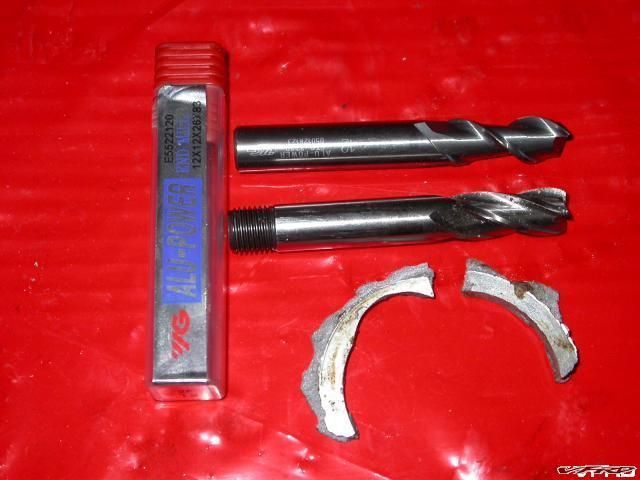 border='0' alt='user posted image' />
border='0' alt='user posted image' />cutters.jpg
Cutter at back is Alupower. Front cutter is badly worn end mill. Two pieces that broke out of the steering head.
When I now machined it you could hear how sweetly the new cutter was working. On a cnc machine you simply specify the center and radius of a circle you want to cut & the tool orbits around the center point. You can cut to bearing tolerances. The OD of the lower bearing is 55mm but I was using a 12mm cutter to machine this. On the control panel of the machine you can set the off-set for the tool from the defined path. For a bearing you leave 0,5mm to start with then use light finishing cuts to the final size. The off-set can be set to 0.001 mm (1 micron, or more correctly 1 micrometer = 0.00004 inches) but the machine resolves to 0.003mm. All of this is swamped by tool deflection which is why you need to do the final light cuts, measuring after each. I machined it to size & tapped the bearing race in.
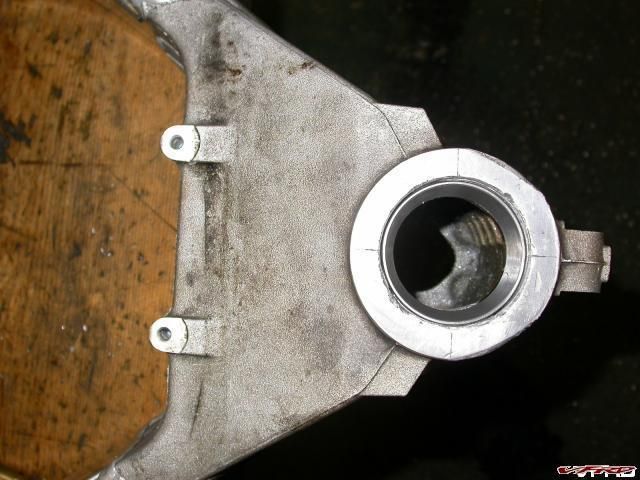 border='0' alt='user posted image' />
border='0' alt='user posted image' />bearing in 2.jpg
I chose to convert to taperd roller bearings. The lower bearing is a standard #320006 bearing but the upper bearing is non-standard. There is no AllBalls here that I can get the required bearing which has a 26mm bore. The closest is #32005 which has a 25mm bore. I got one of these & ground the bore to 26mm on my Haas. I have a 5x spindle speeder into which I fitted a little mounted point grindstone which I spun at 20 000 rpm (speeder maximum). Taking 0.02 off-set increments I ground it to 26mm. You want to have a lot of cutting oil when grinding as the dust must not get into the slideways of the machine. I am very reluctant to ever grind in my Haas.
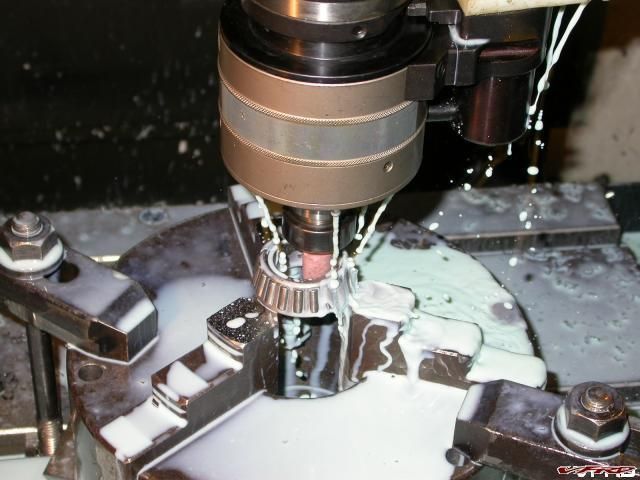 border='0' alt='user posted image' />
border='0' alt='user posted image' />grind bearing 2.jpg
Grinding the upper bearing to size.
-
tok--
3)? Instead, spend your time getting the kit direct from FactoryPro (I can't imagine why they wouldn't send it to you!) or enlist the help of one of your VFRD brothers to buy it and ship it to you.? Maybe you will become the South Africa distribution rep!!
There are three problems with getting stuff sent in:
1. Customs duty. I once brought in a load of CD's direct from Rhino. The duties ended up at THREE times the cost of the CD's. At that stage you simply have to pay.
2. Theft in our post office. A national scandel a while ago but much improved over the last few years.
3. Paying for the things. I ordered a pair of binoculars from a US site about 4 months ago & they said my credit card would not work. The big places like Amazon have no problem with it but smaller places seem to have difficulty.
So I hope to get my binoculars this month through a person comming to Cape Town on a visit. Huge advantage as he has the binoculars as part of his stuff so no customs duty problem.
Any VFRD members comming to Cape Town let me know. Can use my bike (when it's fixed as I dropped it last month). I particularly would like to do BLS 'titanium butt' mod.
You guys really have something in EBay that I envy.
Finally, I like to make things myself. I have a cnc mill so could easily make the spider wheel myself; it is just a matter of time & priorities.
-
The bore of the Factory Pro star wheel looks much smaller than the stockie in your photo. Must be an optical illusion since it all fitted together no problem.
What is to prevent you from simply replacing the plain wheel on the stock arm with a ball bearing? I appreciate that you will not have the revised star wheel profile & slightly stiffer spring. Factory Pro is unlikely to be available to me here.
-
where are the pics? I want to see... : :blink:
Me too; same as for Swiffer's fairing copy process.
-
any images, want to know how it looks.
Me too. Images are all missing, were they from before the Great Crash?

6th Gen Exhaust on a 5th Gen
in Modifications
Posted
Check out vfr800canuck's nickel plated heat shield. More bling in the same area.